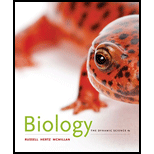
Concept explainers
In the fluid mosaic model:
plasma membrane proteins orient their hydrophilic sides toward the internal bilayer.
phospholipids often flip-flop between the inner and outer layers.
the mosaic refers to proteins attached to the underlying cytoskeleton.
the fluid refers to the phospholipid bilayer.
the mosaic refers to the symmetry of the internal membrane proteins and sterols.
Introduction:
The membrane of the cell is composed of the phospholipid bilayer and proteins. The structure of the membrane is explained by the fluid-mosaic model proposed by Singer and Nicolson. The proteins are distributed unevenly in the bilayer of the lipids.
Answer to Problem 1TYK
Correct answer:
The fluid in the fluid-mosaic refers to the bilayer of phospholipids.
Explanation of Solution
Explanation for the correct answer:
Option (d) is given that thephospholipid bilayer is the fluid part of the membrane. The cellular membrane is formed of the phospholipids and proteins. The fluidity of the membrane is imparted by the phospholipid bilayer, which is amphipathic in nature. Hence, option (d) is correct.
Explanation for the incorrect answers:
Option (a) is given that the hydrophilic sides of the membrane proteins are present towards the internal layer. The proteins present in the membrane are hydrophilic in nature and are present towards the cytosolic or outer sides. They are attracted towards water and span the membrane. So, it is an incorrect option.
Option (b) is given that phospholipids often flip-flop in the layer. The phospholipid layer of the membrane is continuous and uniform. The lipid molecules move sideways rather than flip-flop movement across the inner and outer sides of the membrane. So, it is an incorrect option.
Option (c) is given that the protein attached to the cytoskeleton forms the mosaic part. The mosaic portion of the membrane is formed by the protein. Proteins span the membrane and are present on both the outer and inner sides of the membrane. The inner proteins are attached to the cytoskeleton. So, it is an incorrect option.
Option (e) is given that the mosaic is formed by the symmetry of the internal proteins and sterols. The mosaic region comprises the total proteins present in the membrane. Proteins are unevenly distributed in the membrane. So, it is an incorrect option.
Hence, options (a), (b), (c), and (e) are incorrect.
Therefore, it is concluded that the fluid part of the membrane is formed by the phospholipid bilayer, while the mosaic region is formed by the total protein of the membrane.
Want to see more full solutions like this?
Chapter 5 Solutions
Biology: The Dynamic Science (MindTap Course List)
- There is a species of eagle, which lives in a tropical forest in Brazil. The alula pattern of its wings is determined by a single autosomal gene with four alleles that exhibit an unknown hierarchy of dominance. Genetic testing shows that individuals 1-1, 11-4, 11-7, III-1, and III-4 are each homozygous. How many possible genotypes among checkered eagles in the population?arrow_forwardwhat is this called?arrow_forwardcan you help me identify this it's based on onion rootarrow_forward
- Which evidence-based stress management techniques are most effective in reducing chronic stress and supporting college students’ academic success?arrow_forwardstudents in a science class investiged the conditions under which corn seeds would germinate most successfully. BAsed on the results which of these factors appears most important for successful corn seed germination.arrow_forwardI want to write the given physician orders in the kardex formarrow_forward
- Amino Acid Coclow TABle 3' Gly Phe Leu (G) (F) (L) 3- Val (V) Arg (R) Ser (S) Ala (A) Lys (K) CAG G Glu Asp (E) (D) Ser (S) CCCAGUCAGUCAGUCAG 0204 C U A G C Asn (N) G 4 A AGU C GU (5) AC C UGA A G5 C CUGACUGACUGACUGAC Thr (T) Met (M) lle £€ (1) U 4 G Tyr Σε (Y) U Cys (C) C A G Trp (W) 3' U C A Leu בוט His Pro (P) ££ (H) Gin (Q) Arg 흐름 (R) (L) Start Stop 8. Transcription and Translation Practice: (Video 10-1 and 10-2) A. Below is the sense strand of a DNA gene. Using the sense strand, create the antisense DNA strand and label the 5' and 3' ends. B. Use the antisense strand that you create in part A as a template to create the mRNA transcript of the gene and label the 5' and 3' ends. C. Translate the mRNA you produced in part B into the polypeptide sequence making sure to follow all the rules of translation. 5'-AGCATGACTAATAGTTGTTGAGCTGTC-3' (sense strand) 4arrow_forwardWhat is the structure and function of Eukaryotic cells, including their organelles? How are Eukaryotic cells different than Prokaryotic cells, in terms of evolution which form of the cell might have came first? How do Eukaryotic cells become malignant (cancerous)?arrow_forwardWhat are the roles of DNA and proteins inside of the cell? What are the building blocks or molecular components of the DNA and proteins? How are proteins produced within the cell? What connection is there between DNA, proteins, and the cell cycle? What is the relationship between DNA, proteins, and Cancer?arrow_forward
 Biology: The Dynamic Science (MindTap Course List)BiologyISBN:9781305389892Author:Peter J. Russell, Paul E. Hertz, Beverly McMillanPublisher:Cengage Learning
Biology: The Dynamic Science (MindTap Course List)BiologyISBN:9781305389892Author:Peter J. Russell, Paul E. Hertz, Beverly McMillanPublisher:Cengage Learning Concepts of BiologyBiologyISBN:9781938168116Author:Samantha Fowler, Rebecca Roush, James WisePublisher:OpenStax College
Concepts of BiologyBiologyISBN:9781938168116Author:Samantha Fowler, Rebecca Roush, James WisePublisher:OpenStax College Biology Today and Tomorrow without Physiology (Mi...BiologyISBN:9781305117396Author:Cecie Starr, Christine Evers, Lisa StarrPublisher:Cengage Learning
Biology Today and Tomorrow without Physiology (Mi...BiologyISBN:9781305117396Author:Cecie Starr, Christine Evers, Lisa StarrPublisher:Cengage Learning Human Physiology: From Cells to Systems (MindTap ...BiologyISBN:9781285866932Author:Lauralee SherwoodPublisher:Cengage Learning
Human Physiology: From Cells to Systems (MindTap ...BiologyISBN:9781285866932Author:Lauralee SherwoodPublisher:Cengage Learning Human Biology (MindTap Course List)BiologyISBN:9781305112100Author:Cecie Starr, Beverly McMillanPublisher:Cengage Learning
Human Biology (MindTap Course List)BiologyISBN:9781305112100Author:Cecie Starr, Beverly McMillanPublisher:Cengage Learning





